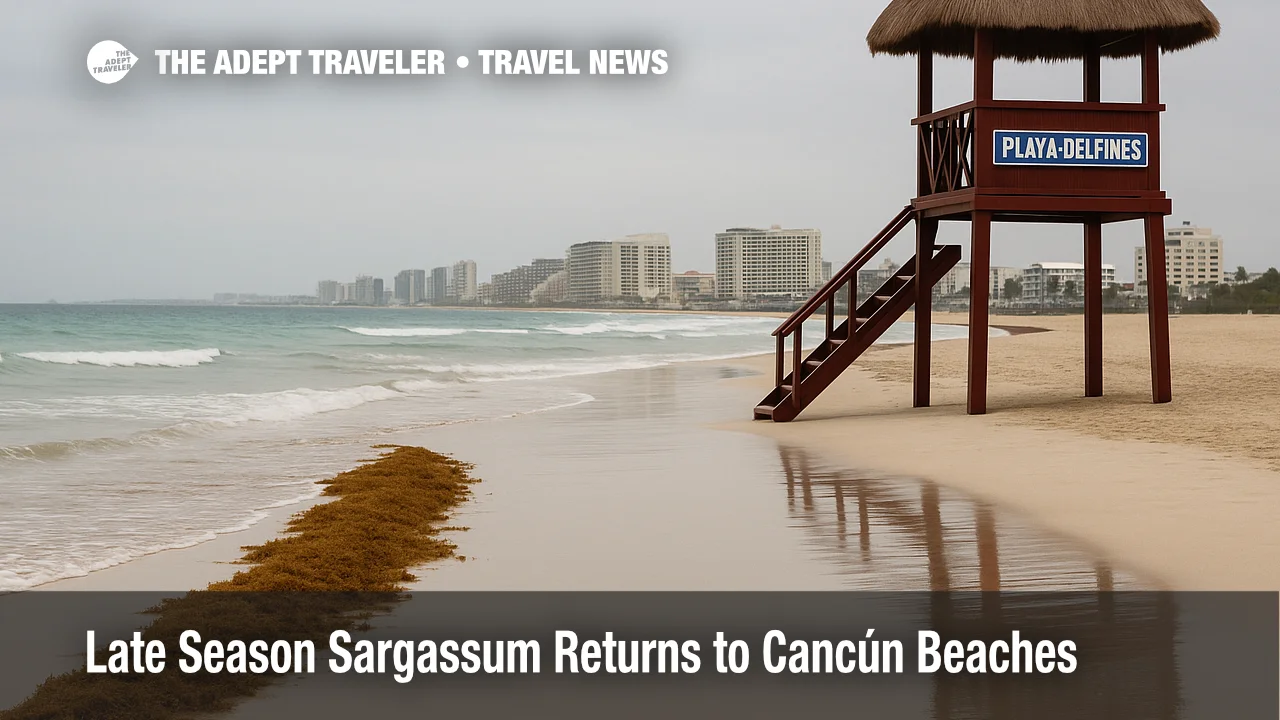Late Season Sargassum Returns to Cancún Beaches

Key points
- Fresh sargassum landings were reported this week along the Cancún hotel zone and Puerto Juárez
- Municipal crews are removing seaweed at first light to limit odors, visual impact, and access issues
- Cancún expects to finish 2025 with over 16,500 tons collected, far above 2024 levels
- Arrivals are patchy by beach and can shift with wind and currents through mid November
- Regional monitors still show a general seasonal decline, with late pulses possible after cold fronts
Impact
- Beach Conditions
- Expect variable seaweed lines in the surf and on the wrack line, with clearer water late morning after cleanup
- Activities
- Plan swimming and photos for mid to late morning, consider beach clubs or piers that maintain cleared access
- Health And Comfort
- Avoid thick decomposing piles that can smell of sulfur, rinse after swimming, and watch for small debris
- Alternatives
- Use Isla Mujeres beaches, north facing bays, or cenotes inland when onshore winds concentrate seaweed
- What To Do
- Check your hotel's daily cleanup routine and local sargassum reports before heading out
A late season pulse of sargassum has reached several Cancún beaches this week, surprising some visitors who expected the seaweed season to be over by November. Municipal teams have resumed pre dawn clearing in sections of the hotel zone and around Puerto Juárez to reduce odors and preserve beach access. Officials say the influx is linked to shifting winds and early cold fronts, which can briefly redirect remaining offshore mats toward the coast even as the broader season tapers. Conditions vary widely by beach and change through the day with tides, wind, and cleanup effort.
Cancún and the Riviera Maya
Local reporting notes the heaviest recent deposits between kilometer markers near the start of the hotel zone, plus Playa del Niño in Puerto Juárez. Crews are focusing on tourist frontages first, working at first light to remove new accumulations before heat accelerates decomposition. The municipality expects to close 2025 with more than 16,500 tons collected, a sharp increase over roughly 3,000 tons in 2024. Travelers should expect beach conditions to look better late morning after daily clearing, with patchy lines returning by afternoon if onshore winds persist.
Latest developments
This late return does not contradict the broader seasonal trend. State and regional monitors had already flagged a marked decline by late October, yet also cautioned that cold fronts can push residual patches onshore in November. Recent outlooks from monitoring groups and oceanography labs still show the basin in a downtrend, although localized pulses remain possible when winds turn onshore. On the ground, community and beach groups have posted fresh photos and short clips of new landings near Playa del Carmen and Cancún since the weekend.
Analysis
For travelers, the practical question is timing and location. When crews start at dawn, beaches that looked messy at sunrise often appear significantly cleaner by late morning. North facing or more sheltered spots can stay clearer when trade winds push seaweed toward east facing shores. If you plan a beach heavy day, check your hotel's live updates or nearby webcams first, then time your swim for mid morning or early afternoon after cleanup. If the surf line still shows brown clumps, consider a pool day, a ferry to Isla Mujeres with more protected beaches, or an inland swim at a cenote.
Background
Sargassum is a free floating brown macroalgae that drifts across the Atlantic in the Sargasso Sea and the tropical Atlantic, then rides currents and winds into the Caribbean. Massive spring and summer blooms have intensified over the last decade, linked by researchers to warmer waters and nutrient inputs from major river basins. Governments and the private sector have invested in booms, skimmers, and daily beach operations, but short wind shifts can still overwhelm cleared stretches. Mexico and the Dominican Republic recently proposed a joint initiative to coordinate monitoring and response as part of a wider regional strategy.
Traveler choices. If a particular stretch looks rough, move a few hundred yards down shore or switch beaches entirely, since conditions can differ dramatically within short distances. Ask your hotel about the day's cleanup schedule and disposal practices. Bring water shoes for comfort if the nearshore zone is weedy and consider snorkel spots reached by boat, where clearer water often lies just beyond the surf. Sensitive visitors may wish to avoid freshly deposited piles that can emit a sulfur like smell as they decompose.
Final thoughts
Sargassum arrives in pulses, not as a uniform blanket, so smart timing and flexible plans go a long way. The primary trend is still seasonal decline, but late season wind shifts can send temporary waves ashore around Cancún. Treat each morning as a new baseline, check local reports, and time your beach time after crews have finished the daily clean.
Sources
- Sargassum makes a surprise late season return in Cancún
- Cancún, sargazo vuelve por sorpresa ante los frentes fríos
- Cancun Hit With Sargassum Just As Seaweed Season Comes To A Close
- Sargassum season for Quintana Roo reported to be coming to an early end
- Sargassum Tracker, USF OOL Long Term Outlook
- Mexico, Dominican Republic propose joint efforts to fight sargassum seaweed
